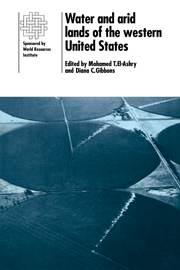Book contents
- Frontmatter
- Contents
- Contributors
- Foreword
- Acknowledgments
- 1 The West in profile
- 2 The Great American Desert transformed: aridity, exploitation, and imperialism in the making of the modern American West
- 3 The Central Valley of California
- 4 Land and water management issues: Texas High Plains
- 5 Water resources of the Upper Colorado River Basin: problems and policy alternatives
- 6 Growth and water in the South Coast Basin of California
- 7 Toward sustaining a desert metropolis: water and land use in Tucson, Arizona
- 8 Water management issues in the Denver, Colorado, urban area
- 9 New water policies for the West
- Appendix: Advisory Panel, Arid Lands Project
- Index
5 - Water resources of the Upper Colorado River Basin: problems and policy alternatives
Published online by Cambridge University Press: 23 March 2010
- Frontmatter
- Contents
- Contributors
- Foreword
- Acknowledgments
- 1 The West in profile
- 2 The Great American Desert transformed: aridity, exploitation, and imperialism in the making of the modern American West
- 3 The Central Valley of California
- 4 Land and water management issues: Texas High Plains
- 5 Water resources of the Upper Colorado River Basin: problems and policy alternatives
- 6 Growth and water in the South Coast Basin of California
- 7 Toward sustaining a desert metropolis: water and land use in Tucson, Arizona
- 8 Water management issues in the Denver, Colorado, urban area
- 9 New water policies for the West
- Appendix: Advisory Panel, Arid Lands Project
- Index
Summary
Background
The Colorado River is the major surface water resource of the Southwest. In spite of John Wesley Powell's forecast that the region would never be useful or inhabited, the river basin has been fought over and romanticized more than any western river. Certainly, it has been the subject of more writing – from geomorphology to politics – than any other western river. Nadeau (1950) wrote of the Owens Valley controversy and of the heroic attempts to conquer the Lower Colorado River. Terrell (1965) described in detail the political battle between Arizona and California over the waters of the Lower Basin, and Fradkin (1968) touchingly described the great changes in the river that have come about through human attempts to control and harness its forces. Throughout this history, the influence of the financial power and the concentration of political power on water issues have dominated the policy scene, and since passage of the Reclamation Act of 1902, the federal government through the Bureau of Reclamation has been the agent of project construction and water supply provision.
The Upper Basin has grown more slowly than the Lower Basin – a typical pattern for development for river basins – generally owing to the superior climate, soils, and accessibility of the Lower Basin. Because the Colorado River's waters are produced primarily by snowmelt in the mountains of Colorado, Wyoming, and Utah, this uneven growth pattern has created a pattern of mutual fears between Upper and Lower basins, the former fearing that the latter would establish title through early use, the latter fearing the former might eventually develop to a point at which it would be using much of the river's water.
- Type
- Chapter
- Information
- Water and Arid Lands of the Western United StatesA World Resources Institute Book, pp. 169 - 232Publisher: Cambridge University PressPrint publication year: 1988
- 6
- Cited by

